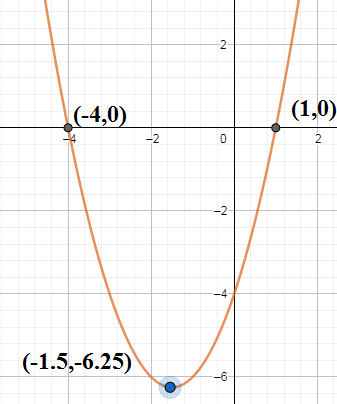
How do you solve ${{x}^{2}}+3x-4=0$ graphically and algebraically? \[\]
Answer
550.2k+ views
Hint: We use the completing square method to solve the quadratic equation$a{{x}^{2}}+bx+c=0$. We first take $c$ to the right hand side of the equation then $a\ne 1$ we divide both sides by $a$. We then add ${{\left( \dfrac{-b}{2a} \right)}^{2}}$ both sides. We make a complete square and then take the square root on both sides. We use the information that $y=a{{x}^{2}}+bx+c\left( a>0 \right)$is the graph of an upward parabola with vertex at $x=\dfrac{-b}{2a}$ and solutions are at the point of intersection of the curve $y=a{{x}^{2}}+bx+c$ with $x-$axis. \[\]
Complete step-by-step solution:
We are given the quadratic equation ${{x}^{2}}+3x-4=0$ in the question; we compare it with general quadratic equation $a{{x}^{2}}+bx+c=0$ to find $a=1,b=3,c=4$. We follows steps of completing the square method and take $c$ to the right hand side to have
\[{{x}^{2}}+3x=4\]
Since $a=1$ we do not need to divide both sides .We add ${{\left( \dfrac{-b}{2a} \right)}^{2}}={{\left( \dfrac{\left( -3 \right)}{2\times 1} \right)}^{2}}={{\left( \dfrac{3}{2} \right)}^{2}}=\dfrac{9}{4}$ both side sides of the above equation to have
$\Rightarrow {{x}^{2}}-3x+\dfrac{9}{4}=4+\dfrac{9}{4}$
Now we shall make a complete square using the terms on the left-hand side of the above step. Let us have;
$\Rightarrow {{\left( x \right)}^{2}}-2\times x\times \dfrac{3}{2}+{{\left( \dfrac{3}{2} \right)}^{2}}=\dfrac{16+9}{4}$
We use the algebraic identity ${{a}^{2}}-2ab+{{b}^{2}}={{\left( a-b \right)}^{2}}$ in the left hand side of the above step to have the complete square as
\[\Rightarrow {{\left( x-\dfrac{3}{2} \right)}^{2}}=\dfrac{25}{4}\]
We take square root both sides of the above step to have;
\[\begin{align}
& \Rightarrow \left( x-\dfrac{3}{2} \right)=\pm \dfrac{5}{2} \\
& \Rightarrow x=\dfrac{3}{2}\pm \dfrac{5}{2} \\
& \Rightarrow x=\dfrac{3}{2}+\dfrac{5}{2},\dfrac{3}{2}-\dfrac{5}{2} \\
& \Rightarrow x=4,-1 \\
\end{align}\]
We graphically solve the problem by plotting the curve in $xy-$plane. We know that $y=a{{x}^{2}}+bx+c$ is the curve of an upward parabola with vertex at $x=\dfrac{-b}{2a}$. Show the points at where the curve $y=a{{x}^{2}}+bx+c$ will cut the $x-$axis will be our solution. So the vertex of the parabola is at $x=\dfrac{-b}{2a}=\dfrac{-3}{2}$ and the plot curve below. \[\]

So we put the curve $y={{x}^{2}}+3x-4$ cuts $x-$axis at the points $\left( -4,0 \right),\left( 1,0 \right)$ . So the solutions of the equation are $x=-4,1$.\[\]
Note: We can alternatively solve by splitting the middle term method if the discriminant $D={{b}^{2}}-4ac$ is a perfect square. Here in this problem the discriminant is $D={{b}^{2}}-4ac={{\left( -3 \right)}^{2}}-4\times 1\times \left( -4 \right)=25$ is perfect square. We can now split the middle tem $-3x$ to have ${{x}^{2}}-4x+x-4=0$ which we factorize to get $\left( x+4 \right)\left( x-1 \right)=0$ from where we get the solution as $x=4,-1$
Complete step-by-step solution:
We are given the quadratic equation ${{x}^{2}}+3x-4=0$ in the question; we compare it with general quadratic equation $a{{x}^{2}}+bx+c=0$ to find $a=1,b=3,c=4$. We follows steps of completing the square method and take $c$ to the right hand side to have
\[{{x}^{2}}+3x=4\]
Since $a=1$ we do not need to divide both sides .We add ${{\left( \dfrac{-b}{2a} \right)}^{2}}={{\left( \dfrac{\left( -3 \right)}{2\times 1} \right)}^{2}}={{\left( \dfrac{3}{2} \right)}^{2}}=\dfrac{9}{4}$ both side sides of the above equation to have
$\Rightarrow {{x}^{2}}-3x+\dfrac{9}{4}=4+\dfrac{9}{4}$
Now we shall make a complete square using the terms on the left-hand side of the above step. Let us have;
$\Rightarrow {{\left( x \right)}^{2}}-2\times x\times \dfrac{3}{2}+{{\left( \dfrac{3}{2} \right)}^{2}}=\dfrac{16+9}{4}$
We use the algebraic identity ${{a}^{2}}-2ab+{{b}^{2}}={{\left( a-b \right)}^{2}}$ in the left hand side of the above step to have the complete square as
\[\Rightarrow {{\left( x-\dfrac{3}{2} \right)}^{2}}=\dfrac{25}{4}\]
We take square root both sides of the above step to have;
\[\begin{align}
& \Rightarrow \left( x-\dfrac{3}{2} \right)=\pm \dfrac{5}{2} \\
& \Rightarrow x=\dfrac{3}{2}\pm \dfrac{5}{2} \\
& \Rightarrow x=\dfrac{3}{2}+\dfrac{5}{2},\dfrac{3}{2}-\dfrac{5}{2} \\
& \Rightarrow x=4,-1 \\
\end{align}\]
We graphically solve the problem by plotting the curve in $xy-$plane. We know that $y=a{{x}^{2}}+bx+c$ is the curve of an upward parabola with vertex at $x=\dfrac{-b}{2a}$. Show the points at where the curve $y=a{{x}^{2}}+bx+c$ will cut the $x-$axis will be our solution. So the vertex of the parabola is at $x=\dfrac{-b}{2a}=\dfrac{-3}{2}$ and the plot curve below. \[\]

So we put the curve $y={{x}^{2}}+3x-4$ cuts $x-$axis at the points $\left( -4,0 \right),\left( 1,0 \right)$ . So the solutions of the equation are $x=-4,1$.\[\]
Note: We can alternatively solve by splitting the middle term method if the discriminant $D={{b}^{2}}-4ac$ is a perfect square. Here in this problem the discriminant is $D={{b}^{2}}-4ac={{\left( -3 \right)}^{2}}-4\times 1\times \left( -4 \right)=25$ is perfect square. We can now split the middle tem $-3x$ to have ${{x}^{2}}-4x+x-4=0$ which we factorize to get $\left( x+4 \right)\left( x-1 \right)=0$ from where we get the solution as $x=4,-1$
Recently Updated Pages
Why are manures considered better than fertilizers class 11 biology CBSE

Find the coordinates of the midpoint of the line segment class 11 maths CBSE

Distinguish between static friction limiting friction class 11 physics CBSE

The Chairman of the constituent Assembly was A Jawaharlal class 11 social science CBSE

The first National Commission on Labour NCL submitted class 11 social science CBSE

Number of all subshell of n + l 7 is A 4 B 5 C 6 D class 11 chemistry CBSE

Trending doubts
What is meant by exothermic and endothermic reactions class 11 chemistry CBSE

10 examples of friction in our daily life

One Metric ton is equal to kg A 10000 B 1000 C 100 class 11 physics CBSE

1 Quintal is equal to a 110 kg b 10 kg c 100kg d 1000 class 11 physics CBSE

Difference Between Prokaryotic Cells and Eukaryotic Cells

What are Quantum numbers Explain the quantum number class 11 chemistry CBSE




